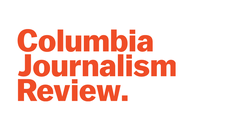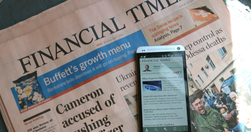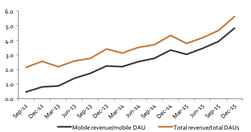Relevant Overviews
- Fediverse
- Communication Strategy
- Content Strategy
- Online Strategy
- Online Community Management
- Social Media Strategy
- Content Creation & Marketing
- Digital Transformation
- Change & Project Management
- Innovation Strategy
- Communications Tactics
- Social Web
- Media
- Politics
- Communications Strategy
- Science&Technology
- Business

From Kickstarter’s April 2009 launch through the end of the year, 17 journalism projects received funding. That number more than tripled just a year later ... 168 funded projects in 2014 and 173 in the first nine months of 2015... from $49,256 in 2009 and $263,352 in 2010 to $1,743,668 in the first nine months of 2015... number of people contribu…

This is a completely new way to launch a media startup,... Most startups start with VC funding or a foundation grant or corporate support and then go chasing after an audience. But our crowdfunding approach means that #EmergingUS will be built on an audience of thousands... treated as real stakeholders. They'll play a big role in shaping the cont…

What if we viewed investigative reporting more broadly ... used our skills (and the financial resources of many investigative teams) to bring people together to solve problems?... The Tribune didn’t just report on what scientists were doing. We came to them with an ambitious idea, connected them to other top researchers and then became an impor…

The afternoon session at Future Media Lab 2016 showed that while European media are warming to the idea of using advanced language technologies to share content across borders, their audiences are already well ahead of them.

Facebook’s Notes feature is giving The Boston Globe another way to post directly to the Facebook platform... Notes, an early Facebook staple, stagnated for years until last September, when Facebook updated the feature with a cleaner, more customizable design and editing tool reminiscent of Medium. Unlike video posted directly to Facebook, there’s…

Betts ... became the first data head to join the publisher’s board, recognizing data’s importance in growing its subscriptions and audience. Today, he heads up a 30-person team focused on customer analytics and research. Here are lessons from Betts on data maturity and driving audience engagement... While subscriptions are critical ... it’s not t…
the hallmark of a good branded podcast is that the marketing is subtle... this is something where you want to build a long-term relationship with people. It’s not about short-term conversions, or anything like that, but about having an amazing first experience with a brand.

Publishers are placing big bets on social platforms like Facebook and Snapchat, praying that fishing for audiences outside their owned sites will eventually pay off in new readers and advertising... it’s still a gamble... payoff in audience and ad dollars is uncertain. Plus, fishing expeditions are hardly free. Hiring more staff is just part of t…

The Wall Street Journal, claims it has been the Journal’s fastest-growing social channel, reaching over 2 million followers since it launched on the Japanese app 15 months ago... Publishers like The Economist, BBC and Mashable have all added Line to their social media arsenal

Advertisers have to spend $250,000 in native plus display over 60 days (up from the minimum BrandVoice package of $150,000). If they don’t get a lift in at least one of four metrics (awareness, favorability, recall, purchase intent), they get their money back.

At work here is what is called, variously, “social syndication” or “traffic exchange,” a technique increasingly in vogue among publishers looking to get their articles and brands in front of other readers ... help them extend the reach ... fill in the gaps in their own social programming with stories that they didn’t or couldn’t write themselves
The Conversation U.S. saw 540,000 unique visitors to its main site last month, but because all of its pieces are published under a Creative Commons license ... it’s reached an audience of 5.5 million... recently announced 19 public and private research universities across the U.S. as its “founding partners.” ... pay a yearly fee and get access to…

“Innovation is not just a cool thing. It’s not just a process. It’s a culture. We research. We design. We build.” Innovation should not compete with the daily grind of the company, it must emerge from it

we’re seeing early signs that the value of a mobile user is greater than a desktop user... Facebook’s... shift from desktop to mobile has led to much higher engagement and average revenue... exactly the opposite of what everyone predicted. investing millions in rich video experiences... But isn’t a larger screen more immersive than a small mobil…

Platforms are eating publishers... The idea that Facebook and its ilk could act as information gatekeepers is also a bleak prospect... Facebook wouldn’t allow The New Republic to create an ad for an innocuous piece on medical marijuana ... If Facebook is squeamish about medical marijuana now, imagine the state of the fourth estate once controversy…

The time has come for The Guardian to make it on its own. Last week, the paper laid out a three-year plan to cut 20 percent of its losses... a re-vamped membership scheme, centralized data teams and a new ad model focusing on video and branded content. Here’s how the Guardian can drive a profit.

Gawker Media CEO Nick Denton was an extreme skeptic of publishers relying too heavily on Facebook. Now he's ... “all in” on publishing directly to Facebook with its Instant Articles program, a backtracking on Denton’s well-publicized lament that publishers are too reliant on platforms...Facebook, with its deep pool of accurate user data, can help …

BuzzFeed has mastered the art of distributed publishing... 5 billion views per month ... across 30 platforms, from Facebook to Pinterest to Snapchat. In a month it does 3 billion video views, less than 5 percent of which are on BuzzFeed.com.... But BuzzFeed must navigate a thorny transition... What’s the ROI of (brand) cat videos? Marketers al…

For journalists, Facebook Live “is a really new way for them to connect,” says Facebook product manager Vadim Lavrusik. “The magic of Live is it's interactive. The people who are viewing the broadcast are just as much a part of it.”

legacy magazine has partnered with WNYC to launch an hour-long radio show ... introduced a metered paywall ... continued to attract sponsors and big names to its annual citywide weekend of panel discussions, interviews and performances.... an Amazon series premieres on February 16...

We first noticed how Trump stories drove traffic—and thus revenue—at TheStreet.com last summer... if a website earns $20 for every thousand page views, it can make, say, $20,000 on a Trump story, but only $2,000 on an article about Cruz, Clinton, Sanders or Rubio... giving him even greater leverage over the media... even the smallest items of Tru…

Ultimately, what publishers and advertisers care about most, however, is how much quality time a person spends with a story. To judge that, publishers are developing newer metrics like “time spent” reading, “scroll depth,” “engagement,” “recirculation,” “shares,” and “percentage of article completed.”

With independent journalism increasingly looking like an endangered species, a EU communication strategy that helped European media build the European Public Sphere would be a smarter longterm move than propaganda and brochureware

The might of Google and Facebook in the digital market, combined with structural changes such as the growth of mobile, which is proving harder to monetise than print, has increased the pace of change since last summer... Guardian Labs, its branded content division launched in 2014, to “make a far, far greater contribution” over the next three yea…
a closer look at what types of comment sections news organizations ... value they are adding to news organizations’ overarching strategies...a list of questions to ask and best practices for news organizations seeking return on investment...key questions, considerations and links to further reading for evaluating what commenting strategy works bes…

The European Political Strategy Centre gathered a select group of leading international academics to provide input to the ongoing public consultation on a regulatory environment for online platforms.
benefit of building a brand that audiences recognize ... allow us to build a strong revenue model and a strong connection to an audience. If they see us on Snapchat and Snapchat has a very large audience, then they get to know and trust Vox and see it as a source that they care about... think about your brand as an interconnected ethos that should…
first U.S. newspaper and first business publication available on the platform ... (U.K.’s Daily Mail is also there).... team consists of five people who will publish eight items each weekday ... “a mix of core coverage, such as Markets, Business, and World news, and the luxury and lifestyle features that we believe provide the perfect snackable c…

Howdy, a bot company devoted to automating common workplace tasks. Its product lives in Slack ... operates in the background, listening for the keywords and questions that will activate its powers. ... automates meetings, asking what people are working on, collating their answers, and distributing them to the team ... take your lunch order ... AI…

Mobile requires a different set of UI/UX and needs different forms of content and advertising, too. That's easy to write, but very hard to implement, especially if you have a newsroom full of experienced people who have learned their trade with a different paradigm in mind. Media startups like vox.com, Buzzfeed, Huffington Post and others... adapt…
Relevant Overviews
- Fediverse
- Communication Strategy
- Content Strategy
- Online Strategy
- Online Community Management
- Social Media Strategy
- Content Creation & Marketing
- Digital Transformation
- Change & Project Management
- Innovation Strategy
- Communications Tactics
- Social Web
- Media
- Politics
- Communications Strategy
- Science&Technology
- Business